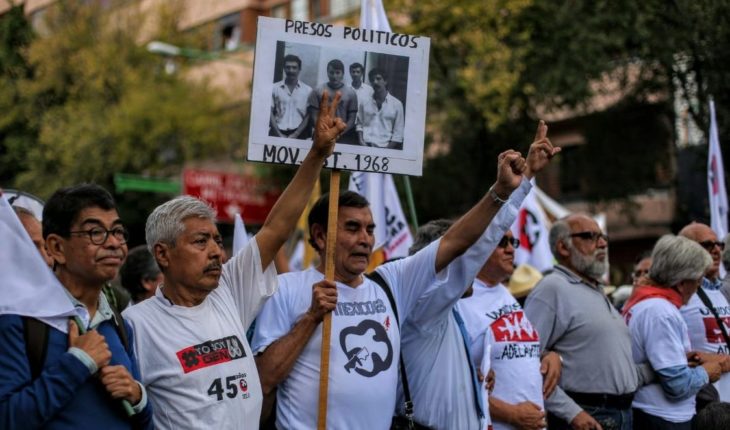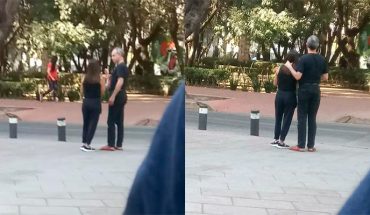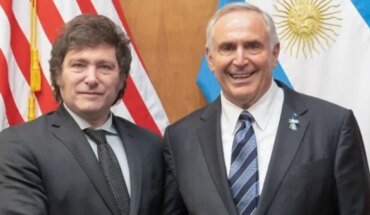on October 2, 1968, from the balcony on the third floor of the Chihuahua building, in Tlatelolco, student leader Eduardo Valle was preparing to give a speech that was written on a paper reading kept in his left pocket, before University students gathered in the Plaza of the three cultures.
However, a helicopter, which dropped a sparkler on, unleashing a hail of bullets, prevented him, and the speech was lost, along with their lenses, in the chaos of the massacre.
Photo: Paris MartínezCincuenta years later, at the foot of the Chihuahua building, Imuris Valley, daughter of Eduardo, now deceased, lamented the loss of that speech, on that night in which his father, as other leaders and members of the student movement, ended in the clandestine cells of Campo Militar No. 1, or in the corridors of the prison of Lecumberri, always known as the Black Palace.
Speech of his father was lost, but Imuris underlined, on behalf of it and the Committee 68 – who joined survivors and relatives of the student movement of half a century ago–, that even with the passage of decades, despite the crushing via military than not be pud or defeat through political, “they can delete, even want, the 68 movement, because it is life, and life flourishes”, and the example, ensures, is present this evening of 2 October 2018 in the square, which now “their children, their grandchildren We’re here to never forget.”
Photo: Carlo EchegoyenEstas were the words with which, formally, began the March to commemorate the massacre of October 2, 1968, when the army fired against civilian, unarmed, population peacefully, manifesting in this same Esplanade.
Convened to start at 16:00 hours, from one hour before the Plaza of the three cultures was already crowded by students of all stamp, students of UNAM, the IPN, the UAM, UACM, the ENAH, the Colegio de Bachilleres, all CCH as well as contingents of Chiapas Morelos and Guerrero, among many others, that in the absence of space stepped from the Esplanade to the avenida Ricardo Flores Magon, as well as Central axis, to embark on the path towards the base of the city of Mexico.
Photo: Lizbeth PadillaLa vanguard of the March, led by the Committee 68 – some of its members in wheel-chair, undertook the trek around 16:10, and 50 minutes later, already bent on calle 5 de Mayo, to insert into the socket.
Meanwhile, two kilometres behind, in the plaza of the three cultures still formed contingent to March, and continued to do so until shortly before 18:00 hours, i.e., almost two hours after he departed the first contingent.
In the Zocalo, soon the flow of students filled the square to the rhythm of the band of Tlayacapan, which accompanied Emiliano Zapata in Morelos squares during the Mexican Revolution, and now opened the meeting and greeted the protesters.
Photo: Lizbeth PadillaA 50 years of the massacre, after the traditional wind band, the first words that spoke out in the main square of the country are the Rosario Castellanos, whose poem “Memorial de Tlatelolco”, rumbles against National Palace.
“Don’t look for what’s not: footprints, corpses
all given as an offering to a goddess,
to the Devourer of excrement.”
“not hurgues files because nothing recorded in minutes.
but behold, it was a sore: is my memory.
it hurts, then it is true. Blood with blood
and if I call her mine betrayed everyone.
“remember, remember.
“this is our way of helping that dawn
on so many tainted consciences,
on an angry text on an open gate,
on the face covered behind the mask.”
“
I remember, remember until justice sits among us.”
The following listening were absent, the fallen in the night of Tlatelolco, half a century ago, and those who were dying then, that “us pain in the heart”, among whom some were mentioned by name, to represent them all and all : Roberta Avendaño Martínez, Carlota Botey, Heberto Castillo, Elí de Gortari, Molina José, José Piñero Guzmán, José Revueltas, Carlos Sevilla, Fausto Trejo Fuentes, Eduardo Valle, and Raúl Álvarez Garín, one of the main drivers of the 68 Committee, died in 2014, whose name was repeated three times, and by it on three occasions, the crowd shouted “Present!”
Photo: Carlo EchegoyenEn point 18:10 hours, the same time that 50 years ago began the attack at Tlatelolco, the protesters gathered in the Zocalo kept a minute of silence, only broken by the murmur of the new contingent following entering the square.
Then was the turn of speech to Félix Hernández Gamondi, Member of the student movement of 68, who (perhaps inadvertently) returned to the same idea that Imuris Valley exposed at the start of the March: the movement of 68 blooming.
Photo: Carlo EchegoyenLuego massacre, narrated Gamondi Hernández, “the student movement was to lick his wounds, to reorganize, to exert and redefined”, and three years later it had recovered to such an extent that, to stop him, the Government again resorting violence, “engrossed with their image of repressive gunman”.
But boomers, followed, did not stop. Some opted for armed struggle, “and were putting forward their blood and their lives, and did so heroically”, underlined, while “many others we went to play the political and organizational experience of the student movement of 68 in trade unions, in” organizations campesino, popular in universities, some as workers formed unions, others as teachers who injected new impetus to education”.
Photo: Carlo EchegoyenEse “desire for freedom”, stressed, is that was expressed after the earthquake of 1985, when the citizen response supplemented the ineffectiveness of Government to the emergency; in 1988, “when it came the great electoral explosion that put in check the regime”, and now in 2018, with the expulsion of the PRI from Los Pinos.
68 experience, concluded, “departed in 68, but not is only 68, but it is an experience that has been built over 50 years”.
Behind him, the fathers and mothers of the 43 fearfully detained and missing in Iguala, Guerrero, 4 years ago, spoke to remember that their children were abducted when they were taking trucks to attend, precisely, the commemoration of October 2, 2014.
For 68 survivors and families of the fallen, the words of the fathers and mothers of the 43 fearfully were short and simple, as well as deep: “we are here present with you, your pain is our pain, 50 years after the Tlatelolco massacre” the memory is alive and we honor the student movement of the 68 “.
For this reason, he stressed, for those responsible for the massacre of October 2, 1968, and for those responsible for the disappearance of the 43 fearfully of 2014, dads and Moms of Ayotzinapa demand the same thing: “we demand jail for all of them, responsible for, which clarify the facts is what we demand as mothers and parents”.
So the pain is the same, in fact, that the slogan for the victims of both attacks by the authorities is the same: don’t forget October 2 / is combative fight… September 26 do not forget, is combative fighting.
Photo: Carlo EchegoyenCuando was still missing half of the March for entering the base, around 19:30 hours (i.e., an hour and half after the rally started on the Esplanade), the speeches concluded, with the reading of the list of demands drawn up by the Inter-University Assembly, which coordinates the student movement started after the porril attack on September 3 students.
Specifications, which require the authorities, is as follows: 1. creation of an independent Commission of the authorities, for the dismantling of the porriles groups and the elucidation of the attack of September 3, 2018, as well as the punishment to the perpetrators and masterminds of these facts.
2. restructuring of punitive strategies of comprehensive security and not in the institutions of higher education and a half top, with a participation of the student, teaching and working community that gives priority to the safety of persons above the of the property.
3 recognition of resolvent instances, with a gender perspective, tripartite and independent, to the creation of mechanisms of prevention, care and punishment in cases of violence against women, in a transparent manner.
4. democratic election of all authorities in the universities, and the Elimination of the authoritarian structures of Government.
5. ensure free education at all levels, emphasizing the upper, and upper levels through the Elimination of all kinds of fees.
6. increase of the budget to education, gives unconditional and transparent resources for the rescue of bankrupt institutions. Dignity of the Faculty and non-teaching, and guarantee unrestricted access to higher education and higher secondary, and that this is public, free, humanistic, artistic, scientific, popular and with a gender perspective.
7. immediate abrogation of the educational reform and the new educational model.
8. inclusion of the student and academic community in the creation, design and implementation of plans and programs of studio.
9 truth, justice, reparation of damage and guarantees of non-repetition in all cases of domestic violence, murders, femicides and disappearances occurring against members of the institutions of higher education and higher secondary.
10 respect for freedom of expression and guarantee of no retaliation against the student and worker education community.
After the lectura of this specification, the 72nd was completed, although only to allow the Tlayacaban band return to traditional wind music. The protest, however, continued beyond socket, in the streets, especially on May 5 of 16 September, by which thousands of students still marched to enter the Plaza, with a common slogan: ‘Never again’.





